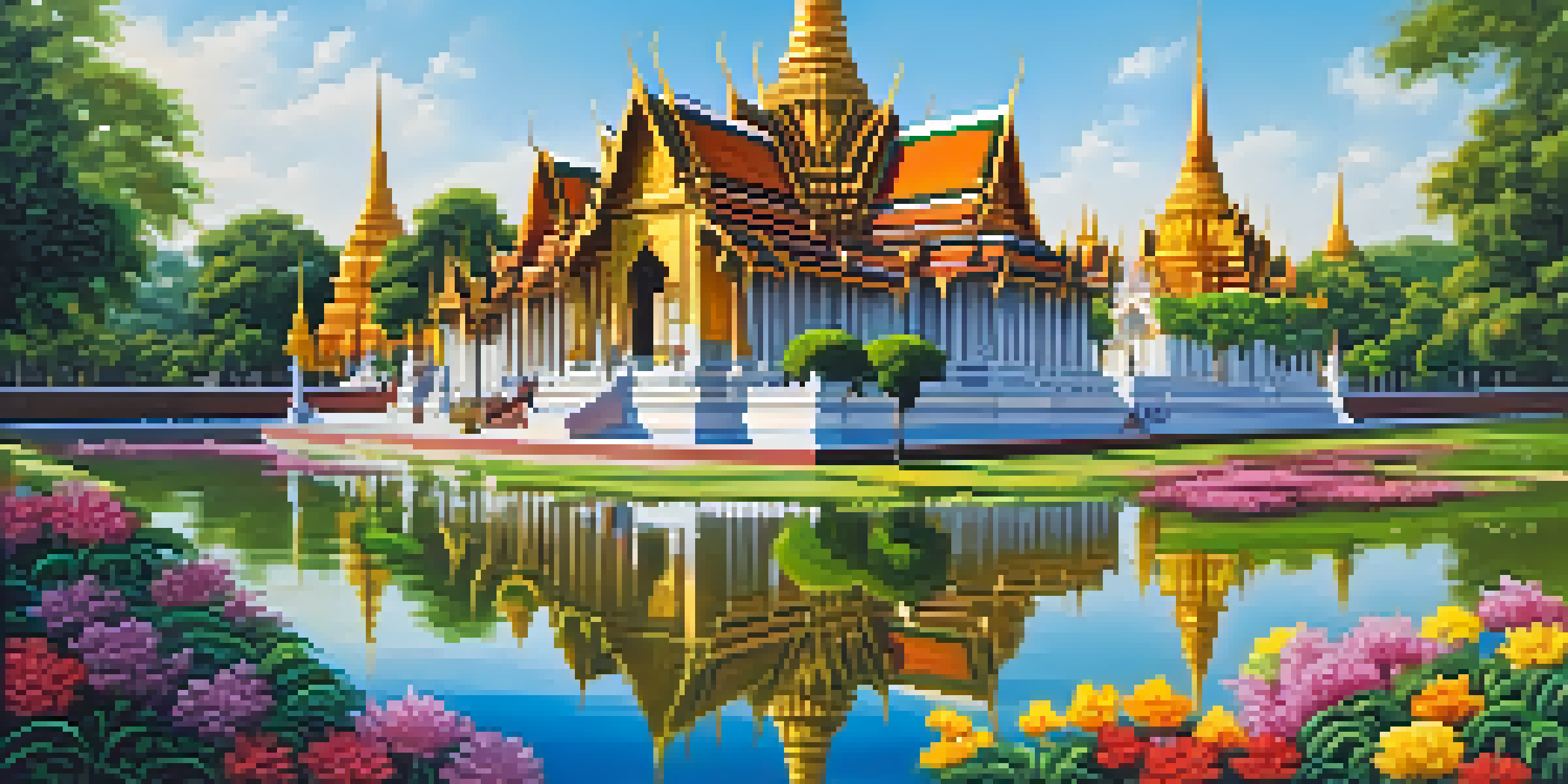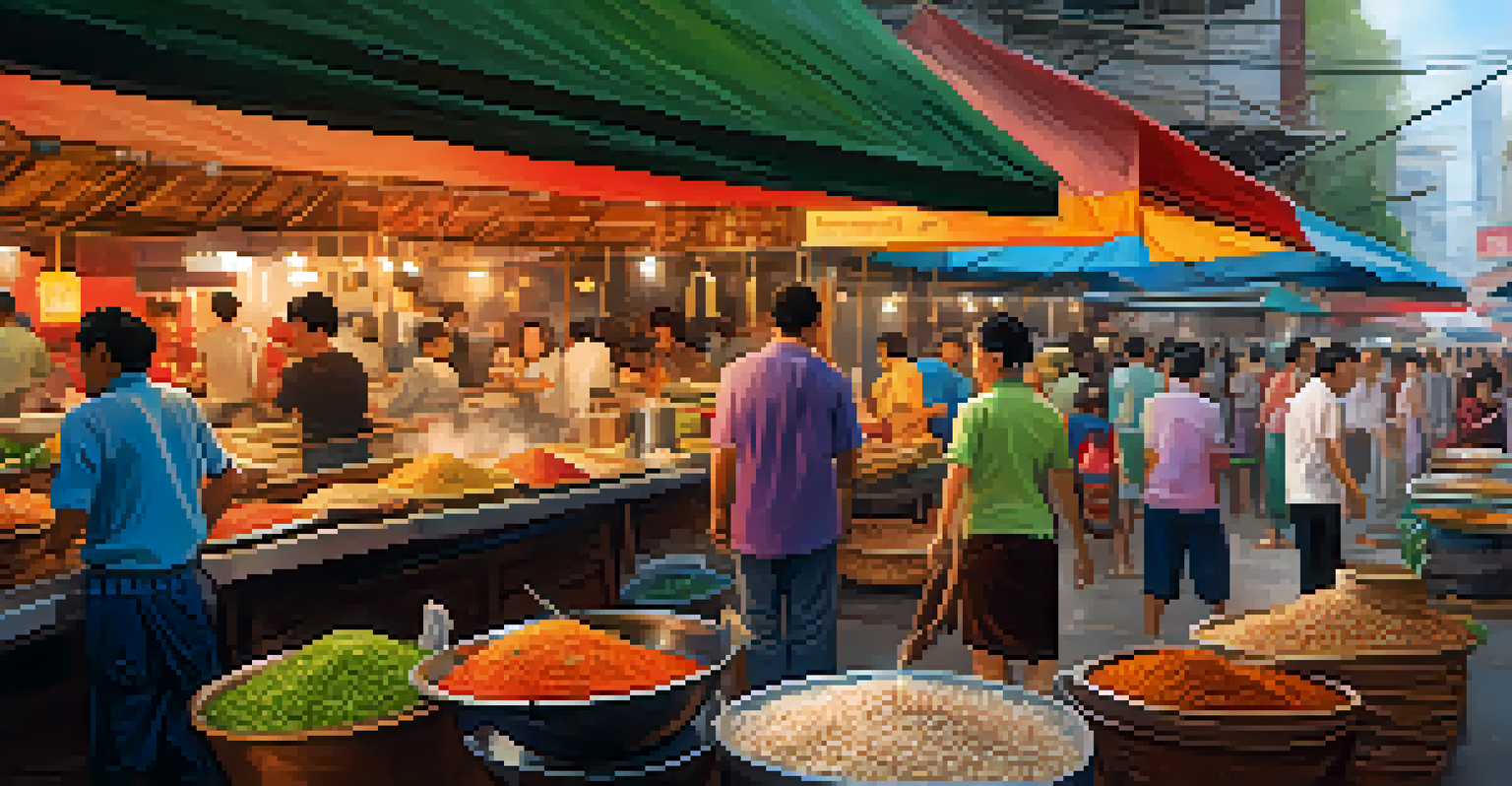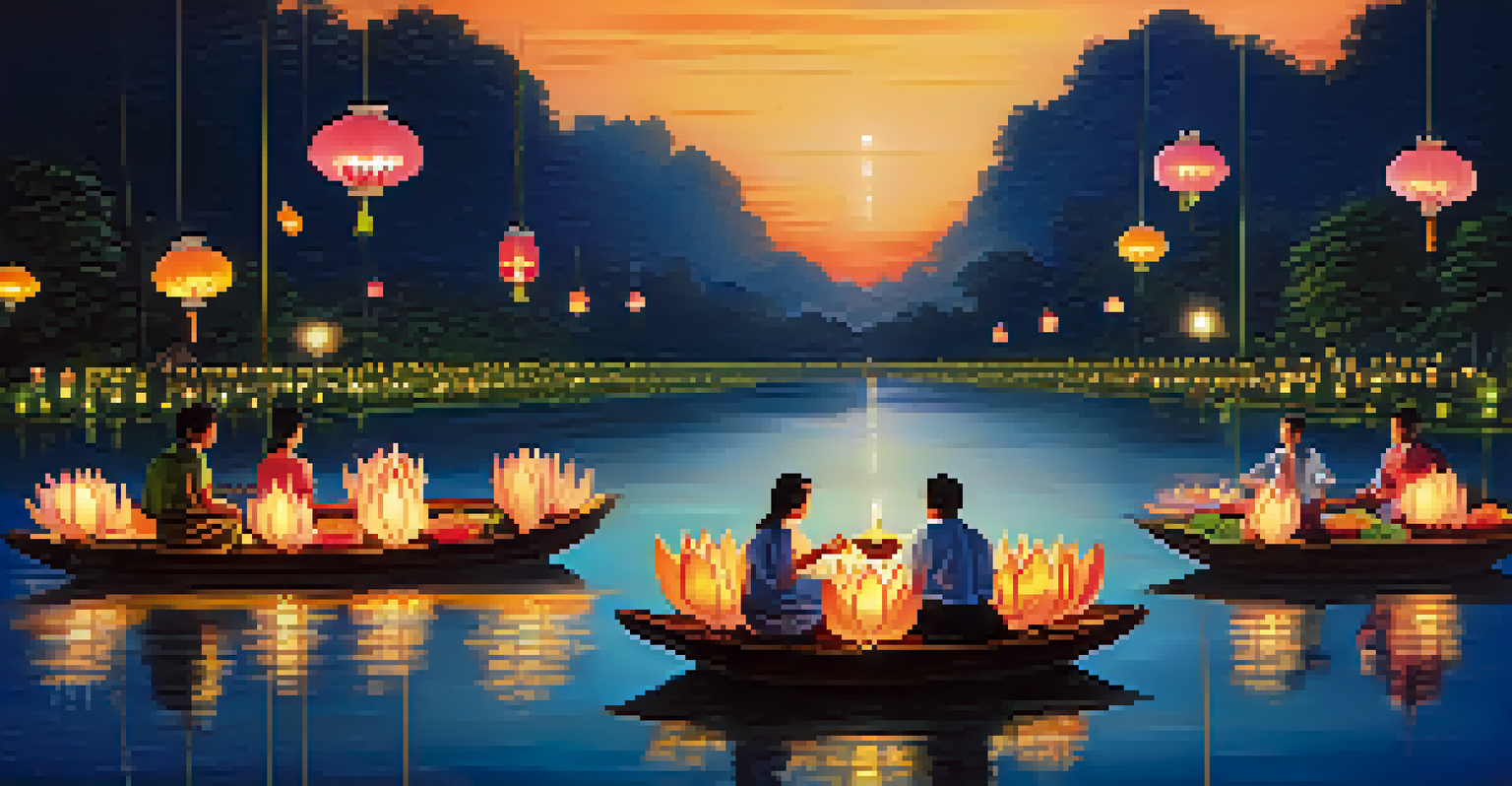Thailand's Cultural Heritage: A Journey Through Time and Space

An Introduction to Thailand's Cultural Tapestry
Thailand, often known as the Land of Smiles, boasts a cultural heritage that is as vibrant and diverse as its landscapes. From the bustling streets of Bangkok to the serene temples of Chiang Mai, each region tells a unique story of its past. This rich tapestry is woven from centuries of history, influenced by various cultures, religions, and traditions. Understanding this cultural backdrop offers a fascinating glimpse into the heart and soul of Thailand.
Thailand is a land of great contrasts, where tradition meets modernity, and the past intersects with the future.
The interplay of indigenous customs with external influences has shaped Thai culture in remarkable ways. For instance, the adoption of Buddhism has not only influenced artistic expressions but also the daily lives of its people. Festivals, cuisine, and architecture reflect a blend of native and foreign elements, showcasing the adaptability and resilience of Thai culture. This cultural melange is what makes Thailand a captivating destination for travelers and historians alike.
As we embark on this journey through time and space, we will explore the key components that define Thailand's cultural heritage. From ancient practices to modern adaptations, each aspect reveals how the country has embraced change while preserving its core identity. Join us as we delve deeper into the rich traditions and historical milestones that have shaped this enchanting nation.
The Significance of Buddhism in Thai Culture
Buddhism plays a central role in shaping Thailand's cultural identity, influencing everything from art and architecture to social customs. The majority of Thais are Theravada Buddhists, and this faith is intricately woven into the fabric of daily life. Temples, known as 'wats,' serve not only as places of worship but also as community centers and educational hubs. They stand as testaments to the artistic prowess and spiritual devotion of the Thai people.

The annual festivals, such as Visakha Bucha and Loy Krathong, highlight the significance of Buddhist traditions in Thai society. These celebrations often involve colorful rituals, offerings, and communal prayers, bringing together people from all walks of life. Through these events, the teachings of the Buddha are celebrated, reinforcing values like compassion, mindfulness, and generosity. Such practices create a sense of unity and belonging among the Thai population.
Buddhism Shapes Thai Culture
Buddhism profoundly influences Thai identity, permeating art, social customs, and daily life.
Moreover, the influence of Buddhism extends into the realm of art, where intricate sculptures and murals depict stories from the life of the Buddha. This artistic expression not only beautifies the landscape but also serves as a means of educating the public about Buddhist teachings. Ultimately, Buddhism is not just a religion in Thailand; it is a way of life that permeates every aspect of culture, offering guidance and wisdom to generations.
Traditional Arts and Crafts: A Legacy of Skill
Thailand's traditional arts and crafts are a vibrant reflection of its cultural identity, showcasing the skills passed down through generations. From intricate silk weaving to delicate pottery, these crafts tell stories of the regions they hail from. Each piece is often infused with symbolic meanings, representing the beliefs and values of the Thai people. By preserving these traditions, artisans keep the spirit of their culture alive.
The essence of Thailand is found in its culture, where every festival, every dish, and every smile tells a story.
One of the most renowned crafts is the art of Muay Thai, a traditional martial art that emphasizes physical and mental discipline. Beyond just a sport, it embodies the values of respect and honor. Similarly, traditional dance forms such as Khon and Ram Thai narrate historical tales through elaborate performances, often accompanied by live music. These artistic expressions serve as a bridge connecting the past to the present.
In recent years, there has been a resurgence in interest towards these traditional crafts, with many young Thais seeking to learn and revive these skills. Workshops and cultural festivals are becoming increasingly popular, helping to educate both locals and tourists about the importance of these art forms. This revival not only ensures the survival of these crafts but also fosters a deeper appreciation for Thailand's artistic heritage.
Cuisine: A Flavorful Journey Through Thai Culture
Thai cuisine is a delightful blend of flavors that reflects the country's rich cultural heritage. Known for its bold flavors and aromatic spices, dishes like Pad Thai and Tom Yum have garnered international acclaim. Each meal is a celebration of local ingredients, with influences from neighboring countries like China and India. This fusion creates a culinary landscape that is as diverse as Thailand itself.
Food plays a significant role in Thai culture, often symbolizing hospitality and community. Sharing a meal with family and friends is a cherished tradition, highlighting the importance of togetherness. Street food markets are a testament to this, where people gather to enjoy a variety of dishes, fostering a sense of camaraderie among locals and visitors alike. The vibrant atmosphere of these markets adds to the overall experience of Thai culture.
Traditional Crafts Preserve Heritage
Traditional arts and crafts reflect Thailand's cultural identity, showcasing skills passed down through generations.
Moreover, many Thai dishes are rooted in ancient customs, with specific recipes passed down through generations. Festivals often feature traditional foods, each with its significance and story. For instance, during Songkran, the Thai New Year, special dishes are prepared to welcome blessings for the year ahead. Through its cuisine, Thailand offers a flavorful glimpse into its cultural soul, inviting everyone to partake in its rich heritage.
Festivals: Celebrating Thailand's Cultural Richness
Festivals in Thailand are vibrant expressions of the country's rich cultural heritage, drawing locals and tourists into a whirlwind of colors, sounds, and flavors. Events like Songkran, the Thai New Year, and Loy Krathong, the Festival of Lights, are deeply rooted in tradition and spirituality. They are occasions for communities to come together, celebrate, and share in unique customs that have stood the test of time.
During Songkran, water fights symbolize the cleansing of sins and bad luck, while offerings to Buddha reflect gratitude and hope for the future. Similarly, Loy Krathong involves floating beautifully decorated lotus-shaped vessels on water, symbolizing the release of misfortune and a wish for good fortune. These festivals not only showcase Thailand's artistic flair but also reinforce the values of community, respect, and renewal.
In addition, participating in these festivals offers a firsthand experience of Thai culture that simply cannot be replicated. Visitors can engage in traditional activities, such as making merit at temples or learning folk dances. This immersive experience deepens the appreciation of Thailand's heritage and highlights the importance of preserving these vibrant traditions for future generations.
Architecture: A Reflection of Thailand's History
Thai architecture is a stunning reflection of the country's history, showcasing a blend of indigenous styles and foreign influences. The iconic golden stupas of Buddhist temples, like Wat Phra Kaew in Bangkok, highlight the importance of spirituality in Thai culture. These architectural masterpieces are not just visually striking; they also serve as symbols of the nation's artistic and religious devotion.
Traditional Thai houses, characterized by their elevated wooden structures and steep roofs, reveal insights into the lifestyle and climate of the region. They were designed to foster community and connection with nature, embodying the harmonious relationship Thais have with their environment. As modernization sets in, the challenge lies in preserving these traditional designs while accommodating contemporary needs.
Festivals Celebrate Cultural Richness
Thai festivals like Songkran and Loy Krathong embody the nation's traditions, fostering community and cultural appreciation.
Moreover, modern Thai architecture is increasingly incorporating sustainable practices, reflecting an evolving cultural consciousness. Buildings that respect the environment while celebrating Thai identity represent a forward-thinking approach to architecture. Through this blend of old and new, Thailand continues to honor its rich heritage while embracing innovation, showcasing the dynamic nature of its cultural evolution.
The Role of Language in Thai Cultural Heritage
Language is a powerful vessel for expressing culture, and in Thailand, the Thai language serves as a key element of national identity. With its unique script and tonal characteristics, Thai is more than just a means of communication; it is a reflection of the country's history and traditions. The language is steeped in proverbs and idioms that encapsulate the values and beliefs of the Thai people.
Learning the Thai language can open doors to understanding the nuances of its culture. Many traditional songs, stories, and folklore are deeply intertwined with the language, offering insights into the Thai way of life. Mastering even a few phrases can enrich a visitor's experience, fostering connections with locals and providing a deeper appreciation for the culture they are encountering.

Additionally, the preservation of the Thai language is crucial in maintaining cultural heritage. Efforts to promote literacy and education in Thai ensure that future generations remain connected to their roots. As globalization continues to influence languages worldwide, protecting the Thai language reinforces cultural pride and identity, ensuring that the essence of Thailand endures through time.